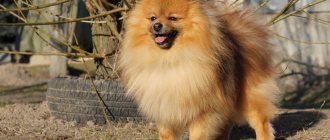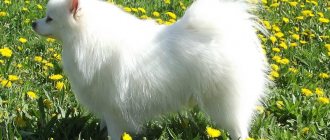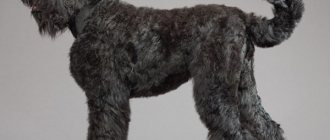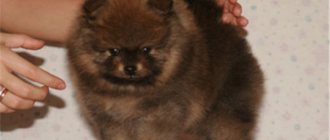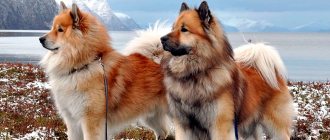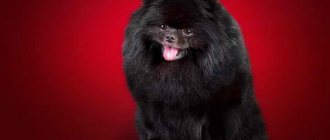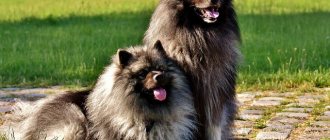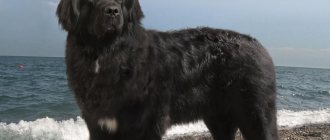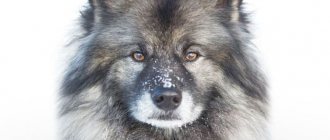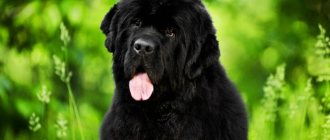| Origin: | Germany |
| Usage: | companion, watchman |
| Color: | various |
| Dimensions: | 20-55 cm |
| Lifespan: | 15 years |
The German Spitz is absolutely charming. He resembles a cross between a fox, a bear cub and a lion. And behind the sweet appearance hides a fearless guard, a curious mischief-maker and an understanding companion. This fur ball with triangular ears and beady eyes has captivated thousands of people since ancient Rome and continues to win the love of millions of dog lovers today.
Standard requirements
The German Spitz breed standard differs in different countries. Thus, FCI and RKF classify all varieties into one group. And in the USA and England, the Keeshond and the German miniature Spitz are considered separate species.
5 types – 5 standards
The FCI German Spitz breed standard identifies the following species:
- German Wolfspitz Keeshond. The color is wolf (zonal gray), height – 43-55 cm.
- Large German Spitz or Grossspitz. Reaches 42-50 cm. Color – brown, black, white.
- Medium German Spitz or Mittelspitz. Color – red, black, zoned, brown, white. Other suits provided for by the standard are allowed. Height – 30-38 cm, weighs up to 11 kg.
- Small German Spitz or Kleinspitz. The suit options are the same as for the Middle Spitz. Size – 23-29 cm.
- German Miniature Spitz, also Pomeranian or Pomeranian. The color is the same as that of the medium and small German Spitz. Height 18-22 cm.
The standard allows other colors: cream, sable - orange or cream, black and tan and spotted colors. The last suit implies a basic white background with spots. It can be black and white, brown, gray or orange and white.
The weight of the German Spitz corresponds to its size. Height below 18 cm is considered a defect. However, fashion dictates its own rules, and today the German Dwarf Spitz has appeared.
Although the German Mini Spitz is not recognized as a standard breed, its popularity is off the charts. It comes in two types: bear-type and doll-type. The dogs of these varieties have cute faces that resemble seals or bear cubs. However, they are living toys. Pets carry the dwarfism gene. Such animals are a degeneration of the breed.
Wolfspitz photo
Photo of Grossspitz.
Photo of the Mittelspitz
Kleinspitz photo
Photo of the orange
General requirements
Apart from differences in size and color, the German Spitz breed standard is common to all dogs. The table below reflects it.
| Options | Characteristic |
| Frame | The back is not long, straight with a wide loin. The belly is tucked in, the chest is wide and voluminous. |
| Leather | Fits tightly to the body, without folds. |
| Head | Medium, wedge-shaped, but not sharp. The ratio of the muzzle to the skull in Keeshonds, large and medium-sized dogs is 2:3, in small and Pomeranians it is 2:4. |
| Neck | Relatively long, wide at the shoulders, with a slight bend. Decorated with a mane. |
| Ears | Small, triangular, pointed. |
| Eyes | Almond-shaped, small, stand slantingly. The color is dark, the eyelids are black, in brown dogs they match the color. |
| Nose | Small, round, matching color. During the seasonal change of coat, in cream-colored dogs and in old dogs, lightening the middle of the lobe is acceptable. |
| Lips | Without jowls, tightly covering the teeth, pigmented to match the color. |
| Bite | Scissor-shaped, perhaps pincer-shaped. |
| Forelegs | With well-developed muscles, elbows pressed to the chest. |
| Hind limbs | Muscular, straight. Abundantly cleaned - so-called. skirt or pants. |
| Paws | In the shape of a cat's paw. The pads and claws are black. |
| Tail | It stands high, rises from the base to the top, is twisted into a ring and lies on the back. |
| Wool | Double, without curls. The spine is straight, the undercoat is abundant and fluffy. The neck, chest, belly, back, tail, back of the limbs are covered with long hair. An adult dog's coat should be silky to the touch, not cottony or fluffy. |
Description of the characteristics of the German Spitz
All types of German Spitz have a body structure similar to a square: the body length and height at the withers are equal. Dogs have a wide chest, a straight back, strong limbs, and the elbows of the front paws are pressed to the body.
The high-set tail is wrapped in a ring, pressing against the dog's back. The proportions of the muzzle and head are slightly different: in medium and large dogs the muzzle is one part shorter than the length of the head; in small subspecies - into two parts.
In all subspecies, the muzzle narrows significantly towards the nose, giving it a resemblance to a fox, this is especially noticeable in dwarf individuals. The ears stand upright, are set close together, and are triangular in shape. The forehead line is smooth, the eyes are almond-shaped.
According to the standard, the bite must be correct; in Pomeranians a pincer bite is allowed. All representatives have thick, soft fur. The guard hair is long and does not adhere to the body; the undercoat looks like fluff.
A thick “collar” frames part of the chest and neck; shorter hair on the muzzle; longer, more fluffy hair adorns the tail.
Did you know? A Spitz named Marco, brought from Italy, won the love of Queen Victoria of England. According to the recollections of eyewitnesses of those years, she did not part with her pet even at receptions and official meetings. Marco had his own security.
Behavior
The character of the German Spitz is unique. From the first days of its existence, the breed developed alongside man, helping him farm and brighten up his days. That's why dogs know how to adapt. With calm owners, they lie on the sofa under the steady hum of the TV, with lovers of sports and outdoor activities, they explore the world.
This does not mean that dogs are couch potatoes. They are active, they need to play, walk and be mischievous every day. It’s just that the character of a German Spitz depends on the temperament of the owner. The saying that dogs are like their owners suits this breed like no other. With choleric people they will be hyperactive, with phlegmatic people they will be calm.
All types of German Spitz are sociable and cheerful. They love family. But the attitude towards strangers is different. Decorative breeds are usually friendly, while others are wary of strangers.
Like any dog, Spitz dogs have advantages and disadvantages. They are devoted to their owner and household members, love affection and participate in everyday affairs. But they cannot stay alone for long, even in the next room. You should prepare for the fact that a furball will follow a person around the apartment and poke its nose everywhere. Sometimes it's annoying.
Another disadvantage is excessive loud barking. You can recognize a German Spitz by its abrupt voice, even without seeing the dog. They need to be told everything about even minor events - the arrival of neighbors, a conversation behind a wall, a car passing under the window. They are weaned off this from puppyhood.
Animals are companions that will follow their owner through thick and thin. No matter what a person does, they will be there. After all, the company of people is the best reward for them.
Suitable for which owner depending on the type
Large species of the breed are suitable for active owners; they will keep company on a morning jog, walk, or active outdoor recreation.
Physical activity is necessary for the dog’s physical development and the feeling of being needed by the owner and belonging to his way of life.
Keeshonds and large Spitz dogs will be good nannies and guardians of children, in addition, they are often companions of people with disabilities. They are patient and vigilant, distrustful of strangers and will not let a stranger near their child.
Did you know? The famous English writer and part-time veterinarian James Herriot wrote the story “Seth Pilling and His Ignorance”, one of the main characters of which is a Keeshond.
The middle and small ones love to swim, frolic in the grass, walk and play outdoor games. They do not tolerate loneliness well and need the company of at least other animals.
They are tolerant of children and willingly keep company in the game. Knowing how to adapt to the owner’s character, they can be good companions for older people, the main thing is to give them a walk so that the bursting energy does not interfere with the owner’s rest.
Pomeranians are considered couch dogs, but walks and games are required for them too. Although active, they are the best companions for older people, showing restraint and patience.
Application
Spitz dogs are mainly bred for fun. Due to their high adaptability to the lifestyle and living conditions of people, pets are suitable for families with children, the elderly and single people.
Their lively, good-natured character has made dogs good psychologists. They are used by psychotherapists in working with withdrawn children and adults with post-traumatic syndrome.
At the same time, dogs are watchmen and security guards. They are always on the alert, warning about the visit of uninvited guests and danger. And if something threatens the owner, they will defend themselves without hesitation.
The qualities of protectors are more pronounced in large varieties of the breed. So, the German Dwarf Spitz is just a toy. He doesn’t even want to go outside again. Another thing is a large German Spitz, Keeshond or Mittelspitz. They will not be afraid of the most formidable and powerful enemy.
Origin
Where did this variety come from? It is believed that large Spitz dogs are peasant dogs. They have been known since the 14th century. Small representatives of the breed were valued by the nobility. These dogs accompanied individuals of “blue blood”, while large Spitz dogs were guard and hunting dogs.
In order not to get confused in the subspecies, breeding work began in the 18th century. As a result of this, four directions in the breed were determined, which include the German medium-sized Spitz (Middle Spitz).
Socialization
The German Spitz dog gets along well with children. She will never bite or bare her teeth at the baby, no matter how painfully he pulls the tail or fur. Not the child, but the dog will have to be protected from rough games.
True, not all animals will become nannies. It depends on the character. Some dogs simply play with children, while others pretend to be mother hens and take care of the little ones as if they were their puppies.
Pets are cool towards strangers. How they perceive guests depends on the behavior of the owner. And yet, dogs always remain on guard in case a stranger offends their owner.
Animals are indifferent to cats, rodents and birds. They get along with any pets. However, “Napoleon” lives in small dogs. They consider themselves big dogs, dominant in relation to their relatives. Because of this, clashes and conflicts arise.
Occasionally, German Spitz bullies cats because of the desire to become more important in the hierarchy and get all the attention of a person.
Older German Spitz dogs have a deteriorating character. They are overly suspicious, fall into despair at the hint of separation from their owner, are grumpy and capricious.
Training
German Spitz are inquisitive, balanced animals, positive and ready for active work and varied work. Excessive immaturity, nervousness and fearfulness are breed defects that sometimes occur due to uncontrolled breeding by unscrupulous breeders.
When starting to train a dog, you need to decide how it will be used. If you want to raise a companion, one training method must be used. If you plan to use the dog for sport or protection, use a different one. The programs are mutually exclusive, so you should not change or alternate them.
Spitz quite quickly learn commands from the basic training course: “Come to me”, “Sit”, “Lie down”, “Place”, “Nearby”. It is necessary to practice the command until the animal develops a conditioned reflex - to the point of automatism. This is achieved by repetition frequency. When we talk about repetition frequency, we are not talking about hours of grueling training. Commands are best remembered if you repeat them for 5 minutes, but do this several times during the day in different places.
Training tips:
- Be consistent - the dog must follow the command correctly at all times, not just on the training ground.
- Don't yell at the dog. Be assertive but gentle. Reward with words and treats.
- Use toys to reward dogs who enjoy tug-and-tug games.
- Entrust raising your puppy to an experienced dog handler.
Upbringing
The pets are well trained. Their distinctive features are a sharp mind and unquestioning obedience. Therefore, there will be no problems with education.
The German Spitz dog breed requires a gentle approach. The pets really try to please the owner and do not try to challenge orders or cheat. Therefore, if the dogs do not understand something, it is the trainer’s fault. You cannot be angry with your pets - screams and discontent will frighten them and make them withdrawn.
The general course of Pomeranian training is mastered by six months. Afterwards, they can be taught circus tricks - they dance with pleasure, stand on their hind legs, jump on the owner’s back, and “die.”
No matter how quickly the German Spitz learns the rules of behavior, education cannot be left to chance. No dog is born obedient - it needs to be trained.
Spitz character
If we talk in general terms about what qualities distinguish a Spitz in character, then we can name intelligence, curiosity, and increased emotionality.
Temperament, of course, is largely characterized by the dog’s belonging to a particular breed. But what you definitely can’t take away from any ordinary Spitz is impulsiveness. It is this excessive energy that causes the individuals to become arrogant, cunning antics and rarely subside ringing barking. This deficiency affects almost all types of Spitz. Proper training of your pet will help you cope with this behavior, which should start from a very early age.
Maintenance and care
Any type of German Spitz will get along in an apartment or private house. But not in the enclosure. Only the Keeshond and the Grossspitz will tolerate half-yard housing - and only in the summer.
At the same time, Klein, Pomeranian and dwarf Spitz are residents of high-rise buildings. Even if they are in the house, you cannot let them out into the yard alone.
Another reason why they don’t take their eyes off pets is their tendency to be mischievous. A small electric broom can dig up clumps, uproot bushes and tear out a couple of tiles from a garden path.
Grooming
In general, the care and maintenance of German “chanterelles” are simple. Difficulties arise only with the fur coat. But it is quite possible to cope with a Spitz at home.
The first difficulties appear when dogs exchange puppy fluff for adult fur. They are brushed every day, otherwise hairballs will cover all the furniture and floors.
When the first shedding is over, it is easier to care for your Spitz. The pet is combed twice a week with a comb with long combs. And during the seasonal change of wool - every day with a slicker brush.
In the classical sense, pets do not need a haircut. They only trim the hairs on their belly, paws and tail for a neat appearance.
Some owners cut their Pomeranians' hair like a teddy bear for the sake of fashion. But if you cut off the guard hair and touch the undercoat, the dog’s coat will deteriorate forever, plus skin diseases are possible.
Other procedures include:
- cleaning your ears once a week;
- removal of oxides from the eyes;
- trimming nails every 3-4 weeks;
- Removing plaque from teeth is a problem area for German Spitz dogs; the oral cavity is cleaned every 2-3 days, and moslaki or toothpick treats are given to chew on daily.
Bathing
Caring for German chanterelles includes washing. Bathing procedures are carried out once every 1-2 months, and show dogs are given an additional bath before the competition.
Bathing is difficult due to the thick, waterproof coat. It doesn't lather well and takes a long time to dry. After the bath, the dog is dried with towels and a hairdryer, and combed. If this is not done, the fur coat will fall off, and colds and fungal skin infections are possible.
Walk
Regardless of size, all Pomeranians should take daily walks. Running and playing in the fresh air allow dogs to burn off their energy and promote harmonious physical and psychological development. In addition, walking is a natural way of socialization, getting to know the outside world, other people and animals.
The breed is moderately active - the dog will not accept the role of a sofa cushion. An adult German Spitz should be walked twice a day for at least an hour. This hour is reserved for games and activities.
A small puppy may be afraid of the street at first. He is being taught gradually. The first walks after vaccination quarantine (at 3.5-4 months) last 10-15 minutes. Their duration is increased every week by 5-10 minutes.
Up to six months, puppies are carried down and up stairs by hand; they are prohibited from jumping from surfaces higher than 30 cm. The joints and bones of babies are still forming, and such stress leads to diseases and injuries of the musculoskeletal system.
Feeding
The food of German Spitz is standard. Pets are fed either a balanced diet or prepared food.
When feeding dry granules, the breed's tendency to obesity and allergies to chicken, wheat, and corn are taken into account. Choose super-premium or holistic brands for small active breeds. Some manufacturers produce special lines for Spitz dogs.
Spitz is a fox not only in appearance, but also in character. The dog is inclined to beg for tidbits, refuse healthy food and pretend to be dying of hunger. You can’t follow a lead - feeding with treats will cause excess weight gain, indigestion, problems with skin, coat and teeth.
Health
The German Spitz is an ancient breed with strong genetics. The minimum life expectancy is 11-12 years, the average is 14-15 years.
However, how many years German Spitz live depends on the breed variety. Thus, decorative dogs, especially dwarf ones, are inferior in health to their large counterparts. An important role is played by care, the absence of hereditary defects, and timely elimination of diseases.
Diseases
The German Spitz breed is prone to:
- pathologies of the oral cavity - incomplete set, improper teething, inflammatory diseases of bone units and gums;
- dislocations, bruises and fractures;
- bloating;
- infectious eye diseases;
- nanism - pathology is associated with a violation of the production of growth hormone in the pituitary gland;
- hip dysplasia – found in Grossies and Keeshonds;
- tracheal collapse;
- epilepsy;
- blockage of the paraanal glands - manifests itself in older, sedentary dogs.
In addition, German Spitz are record holders for skin and coat diseases. Any mistakes in feeding and care spoil the appearance of the fluffies. There are black skin syndrome, alopecia X, dermatitis, eczema, and fungal infections. Dandruff in dogs of this breed can be the result of parasitic diseases or internal pathologies.
Vaccinations
Spitz dogs are sold at the age of 2-3 months. Therefore, the breeder gives the first vaccinations. He vaccinates puppies against:
- plague;
- enteritis;
- parainfluenza;
- hepatitis A;
- leptospirosis;
- coronavirus.
If the puppy arrives at a new home before 3 months of age, the owner carries out a revaccination against the indicated virus with the same drug that was used in the kennel. At six months they give a rabies injection. In the future, a comprehensive vaccination is given every year.
What should a Spitz weigh?
There is no exact data on the development of German Spitz by month. The standard even determines body weight approximately. This is one of the few breeds whose weight is formulated approximately based on the general appearance of the pet.
The size of different types of breed is approximately as follows:
- Keeshond – 15-20 kg;
- German Spitz Gross – 25-30 kg;
- Mittelspitz – 11kg;
- Kleinspitz – 8-10 kg;
- Miniature Spitz 1.9-3.5 kg.
There are no weight parameters for dwarf breeds - bear type and baby doll. It is believed that the less the better.
Mating
The first heat in Spitz dogs occurs at 8-12 months; at the same age, male dogs are interested in girls. However, full formation ends by the 2nd, sometimes 3rd, years. That's why the dogs are not untied earlier.
The concern of breeders for the German Spitz is to preserve the gene pool. Great difficulties in breeding to obtain the desired color. For example, you cannot breed two pure white dogs - the offspring will have the dwarfism gene. Therefore, they cross a white dog with a cream dog, and then “lighten” the color from litter to litter.
How to choose a puppy
German Spitz are a popular breed. Often, breeders sell sick or non-compliant kittens. Therefore you need:
- check permission for dog breeding;
- see what the mother and father of the babies look like - they will inherit their features;
- make sure that you have pedigrees, veterinary passports, and certificates of manufacturer victories;
- evaluate how German Spitz puppies behave and feel - they should be playful, without cowardice or aggression, with clean eyes, nose and ears, without coat defects.
The puppy's color changes during its first molt. For example, a brown kitten can grow into a cream dog.
The main thing is to make sure that the breed is suitable for a particular person. Photos of a German Spitz will help little with this - they will only allow you to evaluate the appearance. You need to get to know the breed in person, evaluate its temperament and behavior in person. Before purchasing, they visit exhibitions, kennels, and communicate with dog owners.
How much do puppies cost?
The price of German Spitz is high and varies depending on the type of breed. So, the average cost:
- German Wolf Spitz Keeshond – RUR 30,000;
- orange - 10-20 thousand rubles;
- large spitz – 40,000 rub.;
- Mittelspitz - 35,000 rubles;
- Kleinspitz - 20-25 thousand rubles.
These are prices for pet class pets. Brides cost 2 times more. And show dogs – 3-4 times. The rarest and most expensive German Spitz puppy is the white Grossspitz. Show-class dogs are sold for 120-150 thousand rubles.

